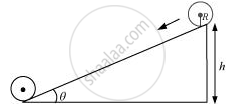Advertisements
Advertisements
Question
Prove the result that the velocity v of translation of a rolling body (like a ring, disc, cylinder or sphere) at the bottom of an inclined plane of a height h is given by `v^2 = (2gh)/((1+k^2"/"R^2))`.
Using dynamical consideration (i.e. by consideration of forces and torques). Note k is the radius of gyration of the body about its symmetry axis, and R is the radius of the body. The body starts from rest at the top of the plane.
Solution 1
A body rolling on an inclined plane of height h is shown in the following figure:

m = Mass of the body
R = Radius of the body
K = Radius of gyration of the body
v = Translational velocity of the body
h =Height of the inclined plane
g = Acceleration due to gravity
Total energy at the top of the plane, E1= mgh
Total energy at the bottom of the plane, `E_b = KE_rot + KE_trans`
`=1/2 Iomega^2 + 1/2 mv^2`
But `I = mk^2 " and " omega = v/r`
`:.E_b = 1/2 (mk^2)(v^2/R_2) + 1/2 mv^2`
`=1/2 mv^2 k^2/R^2 + 1/2mv^2`
`= 1/2 mv^2(1+ k^2/R^2)`
From the law of conservation of energy, we have:
`E_T = E_b`
`mgh = 1/2mv^2(1+k^2/R^2)`
`:.v = (2gh)/(1+k^2"/"R^2)`
Hence, the given result is proved.
Solution 2
Let a rolling body (I = Mk2) rolls down an inclined plane with an initial velocity u = 0; When it reaches the bottom of the inclined plane, let its linear velocity be v. Then from conservation of mechanical energy, we have Loss in P.E. = Gain in translational K.E. + Gain in rotational K.E.

`Mgh = 1/2mv^2 + 1/2 Iomega^2`
`= 1/2mv^2 + 1/2(mk^2)(v^2/R^2)`
`Mgh = 1/2mv^2 (1+k^2/R^2)`
`v^2 = (2gh)/(1+k^2/R^2)`
APPEARS IN
RELATED QUESTIONS
If a rigid body of radius ‘R’ starts from rest and rolls down an inclined plane of inclination
‘θ’ then linear acceleration of body rolling down the plane is _______.
Can an object be in pure translation as well as in pure rotation?
A sphere cannot roll on
A hollow sphere is released from the top of an inclined plane of inclination θ. (a) What should be the minimum coefficient of friction between the sphere and the plane to prevent sliding? (b) Find the kinetic energy of the ball as it moves down a length l on the incline if the friction coefficient is half the value calculated in part (a).
A solid sphere of mass 0⋅50 kg is kept on a horizontal surface. The coefficient of static friction between the surfaces in contact is 2/7. What maximum force can be applied at the highest point in the horizontal direction so that the sphere does not slip on the surface?
A disc of the moment of inertia Ia is rotating in a horizontal plane about its symmetry axis with a constant angular speed ω. Another disc initially at rest of moment of inertia Ib is dropped coaxially onto the rotating disc. Then, both the discs rotate with the same constant angular speed. The loss of kinetic energy due to friction in this process is, ______
What is the condition for pure rolling?
What is the difference between sliding and slipping?
A 1000 kg car has four 10 kg wheels. When the car is moving, fraction of total K.E. of the car due to rotation of the wheels about their axles is nearly (Assume wheels be uniform disc)
An object is rolling without slipping on a horizontal surface and its rotational kinetic energy is two-thirds of translational kinetic energy. The body is ______.
